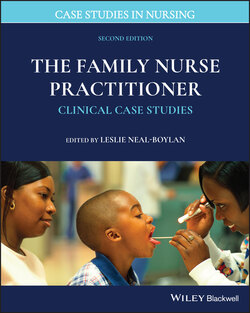Читать книгу The Family Nurse Practitioner - Группа авторов - Страница 25
ОглавлениеCase 2.7 Fall from Height
By Mikki Meadows‐Oliver, PhD, RN, FAAN
SUBJECTIVE
Victor, a 2‐month‐old infant, presents in the office for an examination after he fell off the changing table. He is accompanied by his mother, Amy. Amy states that she was preparing to change Victor’s diaper, and she placed him on the changing table. She then realized that she had forgotten to bring the diaper wipes to the changing table. When she turned around to retrieve the wipes, Victor rolled off the table and onto the floor. Amy states that Victor cried immediately after falling. She did not notice any bleeding after the fall but she did notice bruising on the left side of Victor’s head, which prompted her to bring him in to the office. The injury occurred approximately 1 hour ago. Since that time, Victor has not had anything to eat or drink. He has not had any wet diapers. Amy stated that she did not let Victor sleep after his head injury.
Diet: Normally, Victor takes six 4‐oz bottles of soy‐based formula daily. He has not yet started any solids.
Elimination: Amy states that Victor normally has 6–8 wet diapers daily. He has 2 bowel movements daily. Amy denies that Victor has diarrhea or constipation.
Sleep: Victor normally sleeps 2–3 hours at a time between feedings. He has one 5‐hour stretch of sleep during the night.
Birth history: Victor is the product of a 40‐week gestation. He was born via spontaneous vaginal delivery. During the pregnancy, Amy had no falls or infections. She did not drink alcohol, take over‐the‐counter or prescription medications (other than prenatal vitamins), use tobacco products, or use illicit drugs. His birth weight was 3280 g, and his Apgar scores were 9 at 1 minute and 9 at 5 minutes. Since birth, he has had no other injuries or illnesses.
Social history: Victor was born to an 18‐year‐old mother. He lives at home with his mother and his maternal grandmother. Victor’s father is not involved in his care. His mother does not currently work outside the home but plans to return to work at a local fast‐food restaurant soon. She is looking for child care. The family receives a rent subsidy from Section 8, food subsidies from the Women, Infants, and Children (WIC) program, and food stamps. The family also receives monthly cash assistance from the Temporary Aid to Needy Families (TANF) program. The family has no pets, and there are no smokers in the home.
Family medical history: Victor’s mother has no health problems. His father is 17 years old and has no history of chronic medical conditions. His maternal grandmother (38 years of age) has a history of high blood pressure. His maternal grandfather (39 years of age) also has high blood pressure. His paternal grandmother (48 years of age) is healthy with no health problems, and his paternal grandfather’s health history is unknown.
Medications: Victor is not currently taking any over‐the‐counter, prescription, or herbal medications. He has no known allergies to food, medications, or the environment. He has not yet received any recommended immunizations other than the hepatitis B vaccination received at 1 day of age.
OBJECTIVE
Victor’s vital signs are taken, and his weight in the office today is 5.24 kg. His temperature is within the normal range at 37.1°C (rectal). He is alert, active, and playful. He appears well hydrated and well nourished.
Skin: His skin shows a 1.5 cm × 1.0 cm area of ecchymosis over the left forehead. The area appears mildly tender to touch. There is no cyanosis of his skin, lips, or nails. There is no diaphoresis noted, and he has good skin turgor on examination.
HEENT: Normocephalic with no swelling of the scalp. His anterior fontanel is open and flat (2 cm × 2 cm). Victor’s red reflexes are present bilaterally; and his pupils are equal, round, and reactive to light. He is able to fix and follow the examination past midline. There is no ocular discharge noted. The external ear reveals that the pinnae are normal. On otoscopic examination, the tympanic membranes are gray bilaterally with positive light reflexes. Bony landmarks are visible, and there is no fluid noted behind the tympanic membrane. Both nostrils are patent. There are no nasal discharge and no nasal flaring. Victor’s mucous membranes are noted to be moist when examining his oropharynx. He has no teeth, and there are no lesions present in the oral cavity.
Neck: Victor’s neck is supple and able to move in all directions without resistance. He has no cervical lymphadenopathy.
Respiratory: Respiratory rate is 24 breaths per minute, and lungs are clear to auscultation in all lobes. There is good air entry, and no retractions or grunting are noted on examination. No deformities of the thoracic cage are noted.
Cardiovascular: Heart rate is 116 beats per minute with a regular rhythm. There is no murmur noted upon auscultation. When palpating, brachial and femoral pulses are present and 2+ bilaterally.
Abdomen: Normoactive bowel sounds are present throughout; soft and nontender. There is no evidence of hepatosplenomegaly.
Genitourinary: Normal male genitalia. Victor is uncircumcised and his testes are descended bilaterally.
Neuromusculoskeletal: Good tone in all extremities; full range of motion in all extremities. His extremities are warm and well perfused. Capillary refill is less than 2 seconds, and his spine is straight.
CRITICAL THINKING
1 Which laboratory tests should be ordered as part of a workup after a fall from height?
2 What is the most likely differential diagnosis and why?
3 What is the plan of treatment, referral, and follow‐up care?
4 Does this patient’s psychosocial history affect how you might treat this case?
5 What if the patient lived in a rural setting?
6 Are there any demographic characteristics that might affect this case?
